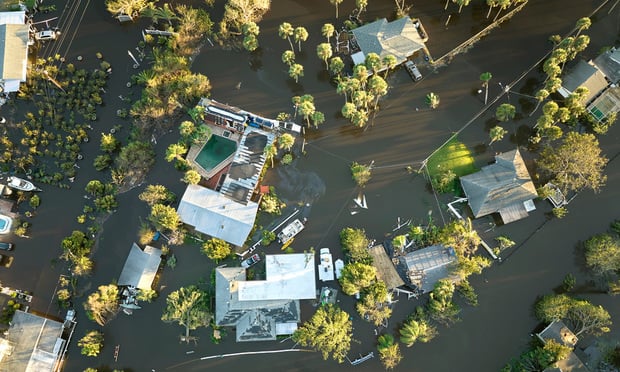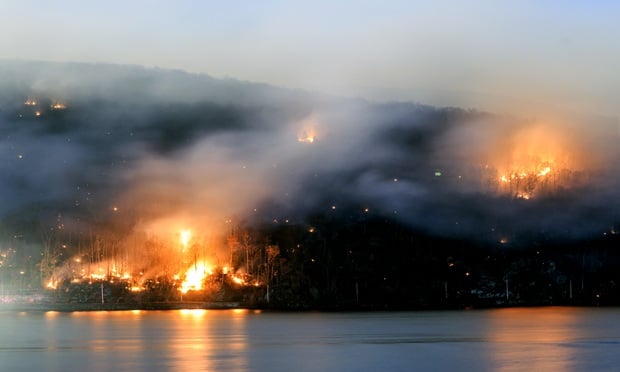Catastrophes may be the single greatest challenge impacting the insurance industry, affecting underwriters, adjusters, and policyholders alike. The shared risk that makes insurance such a viable industry can become financially devastating when thousands of claims pour in following an event like a hurricane, flood, or earthquake. No matter how many horrific events the industry has had to cope with — Atlantic storms such as Hurricane Andrew, floods in the Midwest, tornadoes in metropolitan areas — each catastrophe presents new challenges that call for an evolution of techniques, tactics, and technology.
Few events in American history captured the essence of a catastrophe like Hurricane Katrina. The storm slammed into New Orleans in the last week of August 2005, killing nearly 2,000 people (leaving another 700 missing), and causing more than $80 billion in damages. The immense financial toll and human suffering forever changed the way our society, government, and insurance industry approached forecasted events like hurricanes. It also changed the way people in the path of storms reacted, as evidenced by the mass exodus from Houston a month later prior to the arrival of Hurricane Rita.
Perhaps Katrina's most profound business impact was how the claim cycle also changed as adjusters were prevented from entering the most devastated areas. Carriers had to find new ways to reach their customers just to initiate the claim process and mitigate any further losses due to open and exposed structures and properties.
A Wireless World
Turn the clock back 10 years. Imagine trying to cope with a catastrophic claim event on the scale of Hurricane Katrina minus laptops, cell phones, global positioning systems (GPS), and laser measurement. Devastating events that used to take months to assess and quantify now take mere weeks. The insureds who were once forced to the sidelines after filing claims with their local agent can now, in some cases, witness the progress being made on their claims and properties online. They can also participate by providing elements or data they view missing through a more automated and transparent claim-processing system. The systems continue to evolve as carriers, adjusters, contractors, and even policyholders find new ways to use rapidly-changing technology.
Today, the functionality, clarity, and coverage of cellular telephone and wireless data networks, along with the increased versatility of the Internet, have become crucial tools for adjusters, carriers, and policyholders alike. Insurance carriers have recognized the potential for faster processing of estimates and settling claims. Adjusters are no longer tethered to a landline to fax documentation for estimates. They can now call that information in from the field to a central location that inputs it into a carrier's system and advances the claim through the process. Adjusters in the field can now be reached easily by the carriers, should any questions or concerns arise.
In those early days of cell phone use by claim adjusters, the contact information was only shared internally. But the expansive use of cellular technology increased the demands of policyholders who wanted that contact information for their agents and the adjusters that were working their claims.
Today, anyone is reachable anytime via cell phones. This has also helped customer satisfaction rates, as policyholders can more readily reach their assigned adjuster instead of dialing a call center.
The advances in wireless phones and other devices have also allowed adjusters and others working in the field to reduce the amount of equipment they take with them to a natural disaster. Today's smart phones are beginning to supplement and replace cameras — both still images and video — that adjusters were once forced to lug. Static paper maps have been replaced by GPS units and turn-by-turn information provided through the handhelds. In a number of cases, today's phones can carry out much of the work of a laptop: composing documents, sending and receiving correspondence, and allowing users to interact with both Internet and intranet applications.
Hard Lessons of 2005
The advances in portable technology still were not enough to prepare the insurance industry for the monumental task needed to assess and compensate for all of the damage that occurred in 2005, the most active Atlantic hurricane season on record. The deadliest, of course, was Katrina.
Carriers and adjusters who arrived in New Orleans to begin to assess the damage were unable to travel to the most devastated areas because it was too dangerous. Homeowners struggling to protect their property and belongings were reduced to painting the names of their insurance carriers on the rooftops along with their own cell phone numbers in an effort to get adjusters to call them.
Following the lessons learned and damage reputations from that season, carriers began to aggressively market their responsive services. They aired dramatic commercials featuring new mobile command centers, driving into the heart of a storm to assess damage and distribute settlement checks on the spot. Policies now come with Web addresses and e-mail contact information that allow policyholders to file claims via the phone or Internet.
Should a catastrophe strike, carriers can use predictive dialing technology to send automated messages to their customers via land lines or mobile numbers, urging them to call back with their claim information. It is a way to get issues addressed in an effort to mitigate any additional damage that may result from having an exposed property.
The impact of technology is certainly easing the filing of claims. It is also creating a greater expectation of service and transparency for the policyholders. The immediacy of current communications means that all customers — internal and external — expect to have the ability to reach whomever they need, whenever they need to reach them. That expectation extended from carriers to the independent adjusters, who are essentially extensions of their brand and service attributes.
Technology Accelerates Claim Processing
Online and mobile communications continues to drive claims that come in faster and earlier than ever before after a catastrophe, requiring more coordination between claims and underwriting. The claim communication process now needs to be as strong as ever to help rapidly deploy adjusters to assess damage and contain losses on the ground.
Advancements in weather forecasting are also helping carriers to review exposure in the regions of predicted landfall for hurricanes. Exposure profiling allows for the determination of how much of a presence is needed in the area of a pending event, and also allows for more accurate and effective deployment of claim adjusters.
Today, dashboard technology affords carriers the capability to provide real-time claim information to offer complete transparency in claim processing. Dashboard technology provides a graphic view of all open inventories and allows for the monitoring of real-time claim-handling performance. This performance can be measured against first contact, first report, and claim closing. Monitoring can be used to improve claim-handling performance for carriers and adjusters alike. It also brings the policyholder into the process.
In a catastrophe, dashboard technology enables better management of the avalanche of nearly immediate claims that are being filed thanks to customer-facing technology. But technology is also evolving the typical workflow for claim adjusters. Years ago, the typical adjuster would process roughly 100 claims over a three-month period during a catastrophe. Now, policyholders file claims almost instantly, resulting in a dramatic compression of claims being filed in a shorter time span. This cycle compression creates the need for a much larger adjusting force to handle the same number of claims today than five years ago.
The reason is simple. Many insurers promise to contact the insured within 24 hours of a claim being filed and inspect a property within 72 hours of a claim being filed. If 1,000 claims pour in today versus 500 that would have been filed on the same day five years ago, then it takes twice the number of adjusters. Each adjuster may handle half as many claims over the course of processing a catastrophe, but the affected claims will be resolved twice as fast, which results in a major improvement for victims of catastrophes.
Obviously, this new environment requires independent adjusting firms to deploy many more adjusters to work an event than it would have five years ago, putting an increased burden to recruit and train a larger workforce as well as handle the vastly more complex logistical challenges of larger and faster deployment. In addition to the acceleration of the claim-filing period, carriers have learned that rapid damage and exposure assessments also help prevent the development of mold or exposure to additional damage that frequently increases the costs of settling claims.
Moving Forward
Society continues to find new ways to communicate. New online technologies, social media platforms like Facebook and Twitter, and text messaging have pushed carriers and adjusters to explore this space as a new way of communicating with each other and policyholders. Customers now have the ability to choose the way they want to be contacted, and carriers and adjusters must comply in order to continue to provide the level of service customers are expecting. All of this technology is forever changing the very nature of the claim cycle during a catastrophe.
Outside the online space, companies are developing new technologies that use satellite imagery and aerial photography to expedite the claim process for roof damage. Keeping an adjuster off a potentially dangerous roof that he may have had to measure allows an adjuster to move more quickly through those claims and keeps him from an injury that would slow down the process even more.
Hand-held mobile applications continue to evolve by capturing data, producing estimates, and generally expediting the claim process. These tools can also help to comprehend the skills, workload, and distances adjusters must navigate so as to optimize visits and adjust for agents in the field to maximize the number of visits.
Technology has not evolved to the point where adjusters are taken completely out of the equation. It still requires skilled people on the ground who understand what to look for, know how to value the damage that occurred, and who are armed with the empathy to help deal with the human cost that results from a catastrophe. Those skills are augmented by the knowledge and understanding of the tools that are now at their disposal. It is imperative that carriers and adjusters alike continue to expand that knowledge and make the most of available advancements in order to meet the evolving needs and expectations of all stakeholders affected when disaster strikes.

Want to continue reading?
Become a Free PropertyCasualty360 Digital Reader
Your access to unlimited PropertyCasualty360 content isn’t changing.
Once you are an ALM digital member, you’ll receive:
- Breaking insurance news and analysis, on-site and via our newsletters and custom alerts
- Weekly Insurance Speak podcast featuring exclusive interviews with industry leaders
- Educational webcasts, white papers, and ebooks from industry thought leaders
- Critical converage of the employee benefits and financial advisory markets on our other ALM sites, BenefitsPRO and ThinkAdvisor
Already have an account? Sign In Now
© 2024 ALM Global, LLC, All Rights Reserved. Request academic re-use from www.copyright.com. All other uses, submit a request to [email protected]. For more information visit Asset & Logo Licensing.








